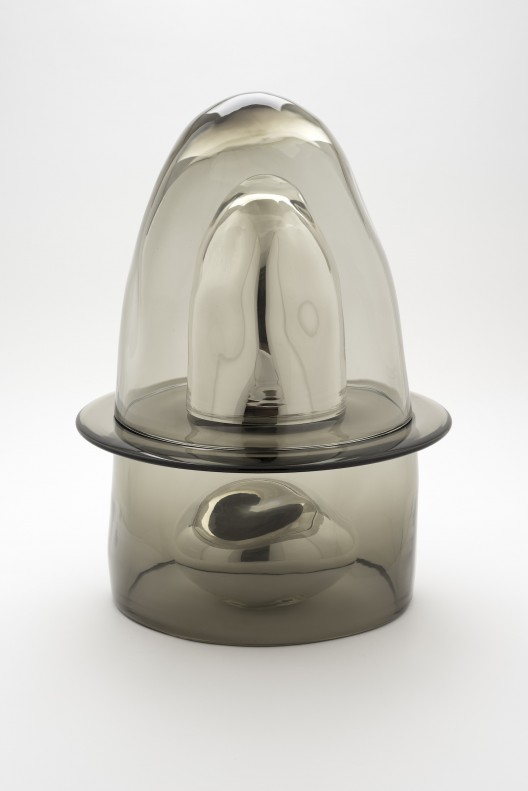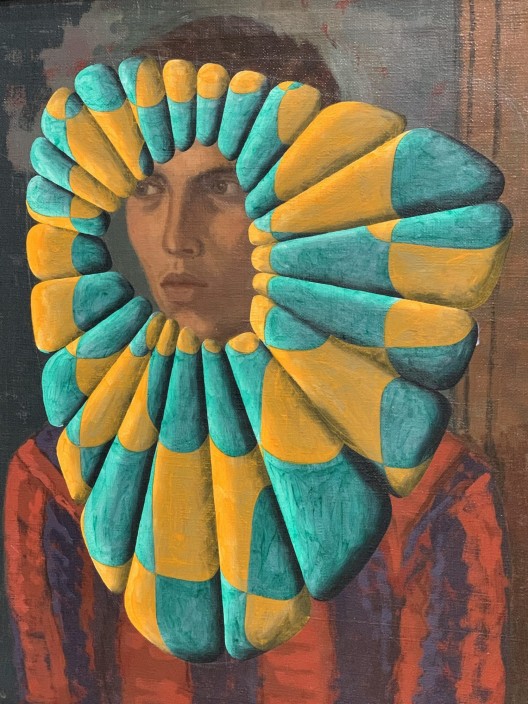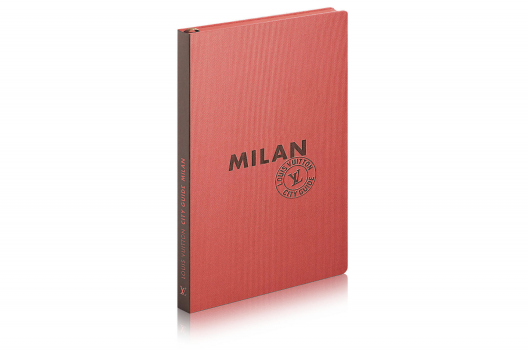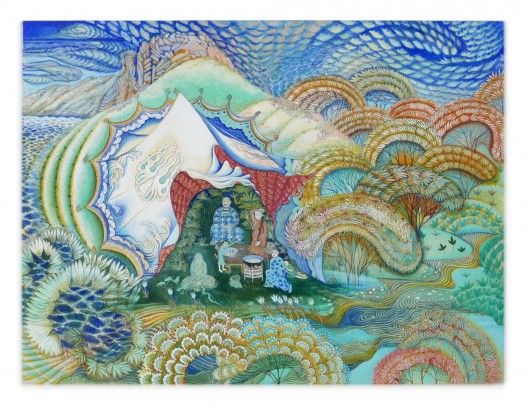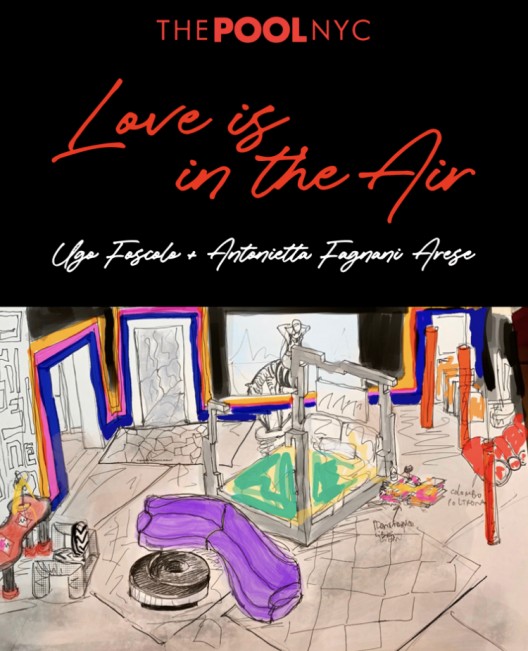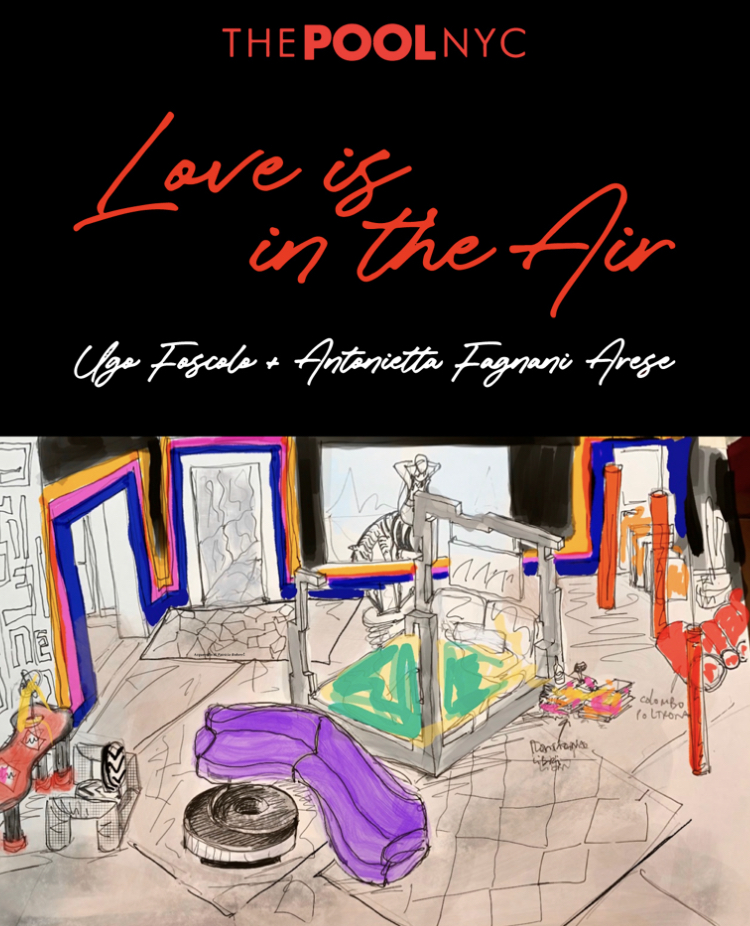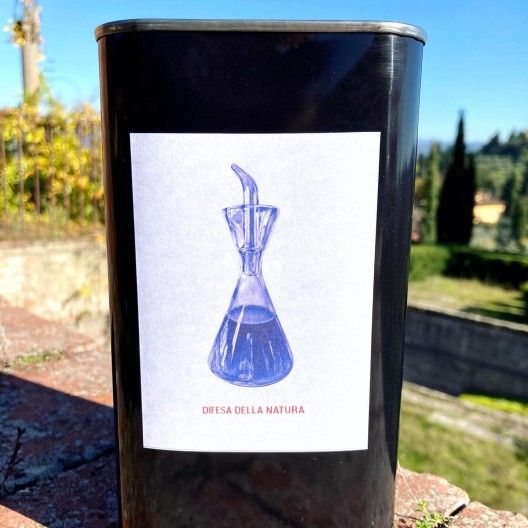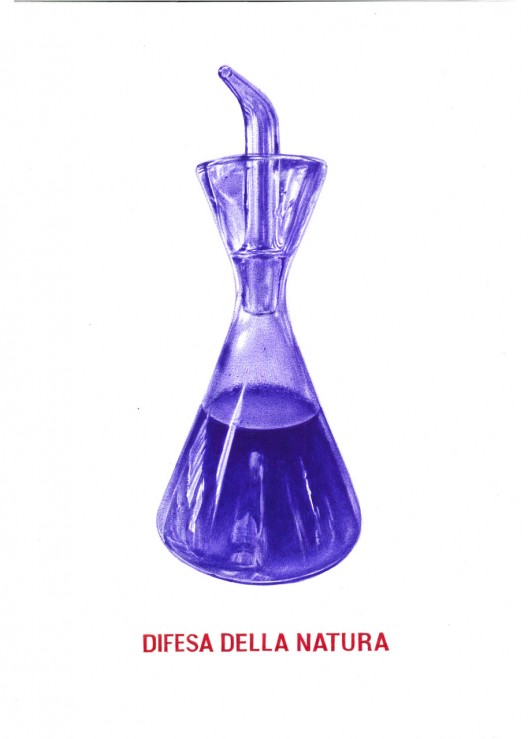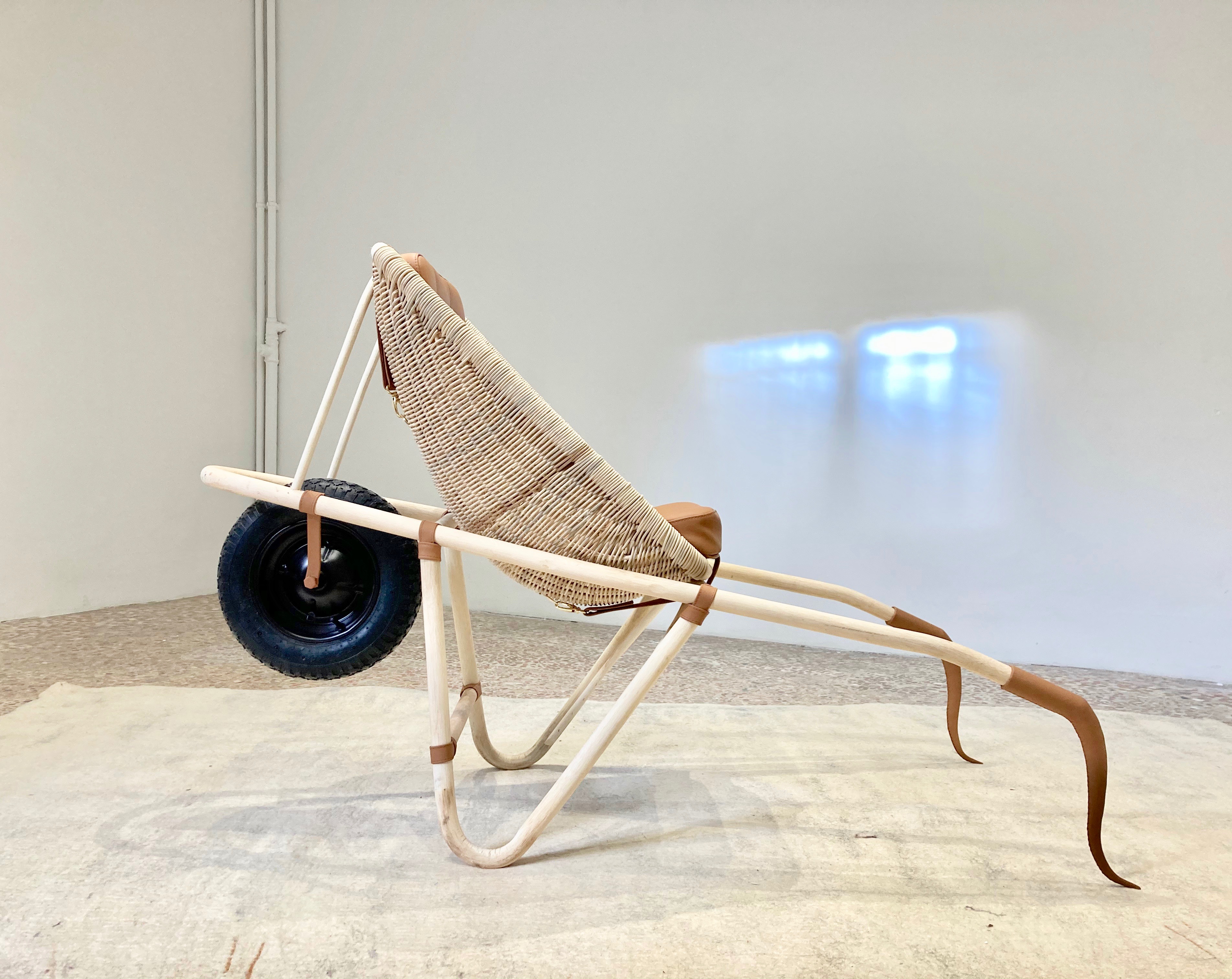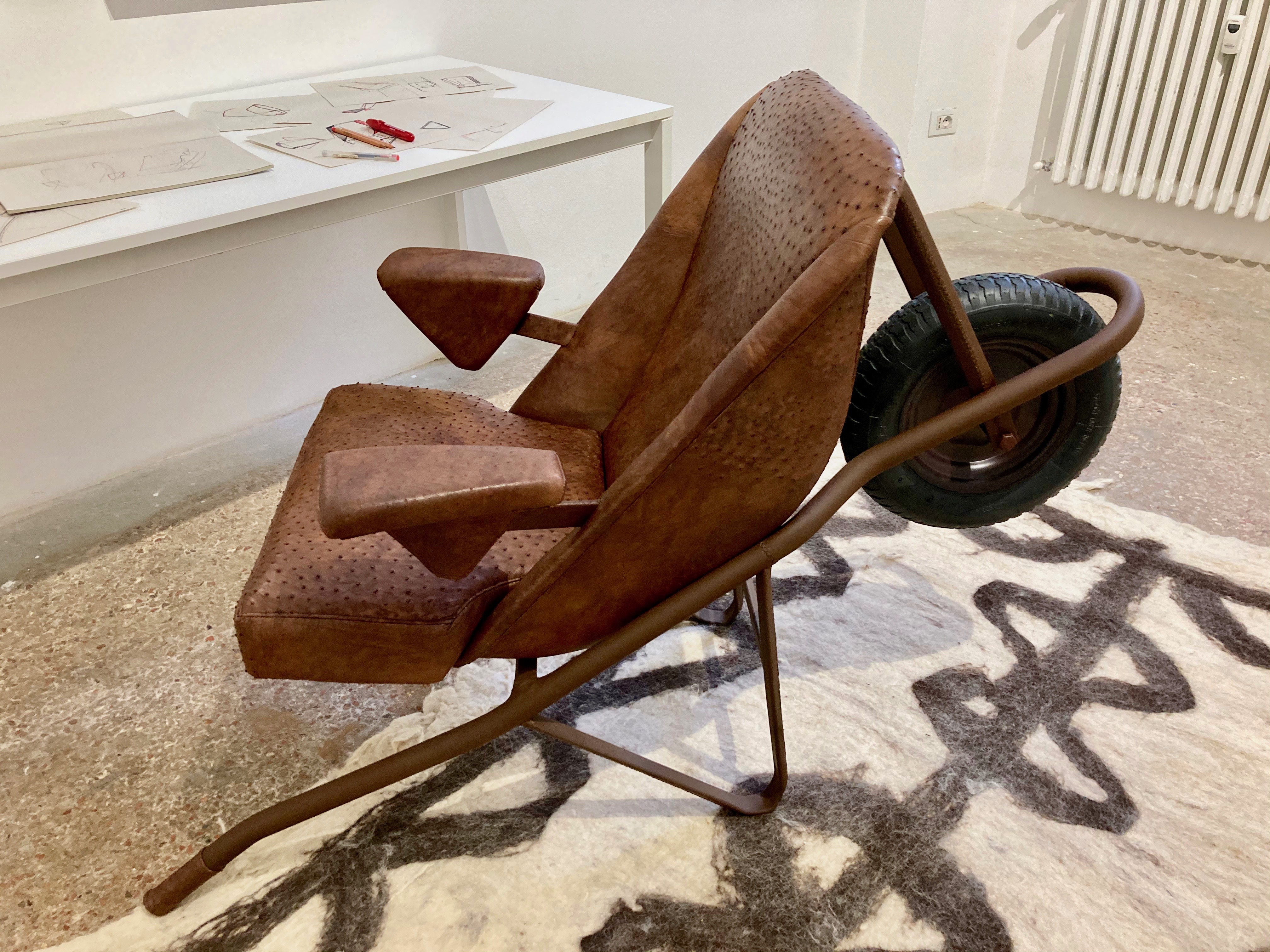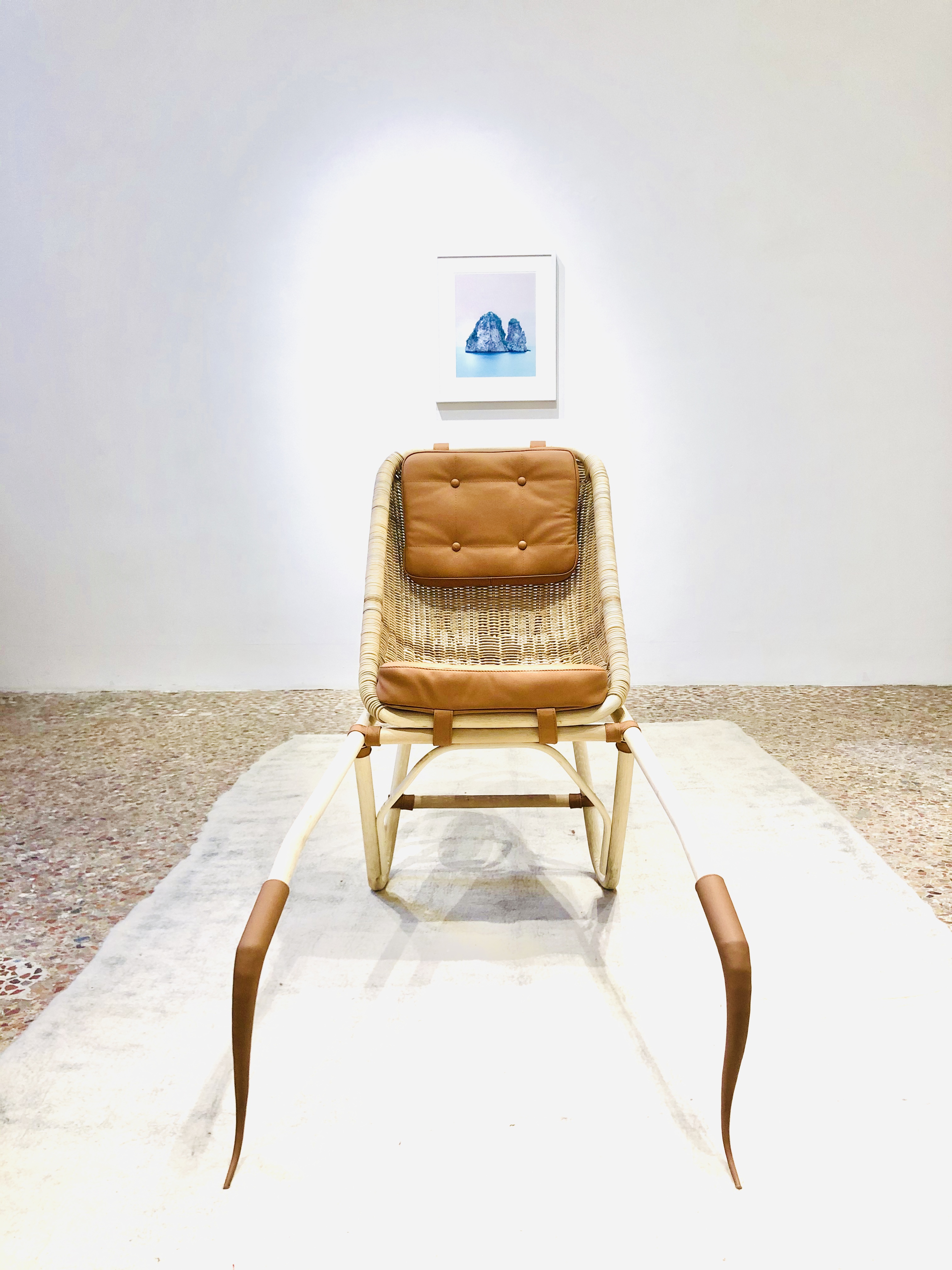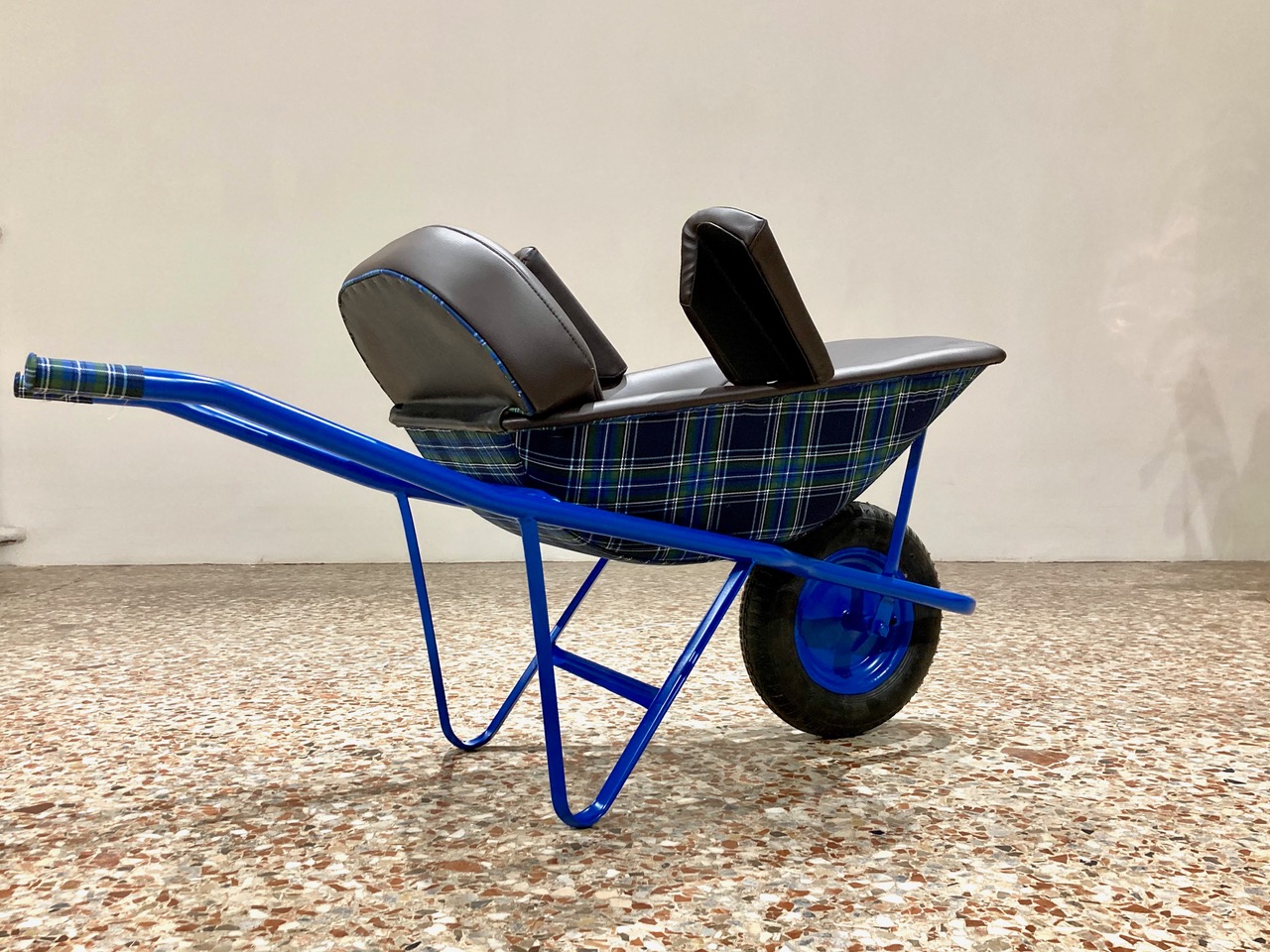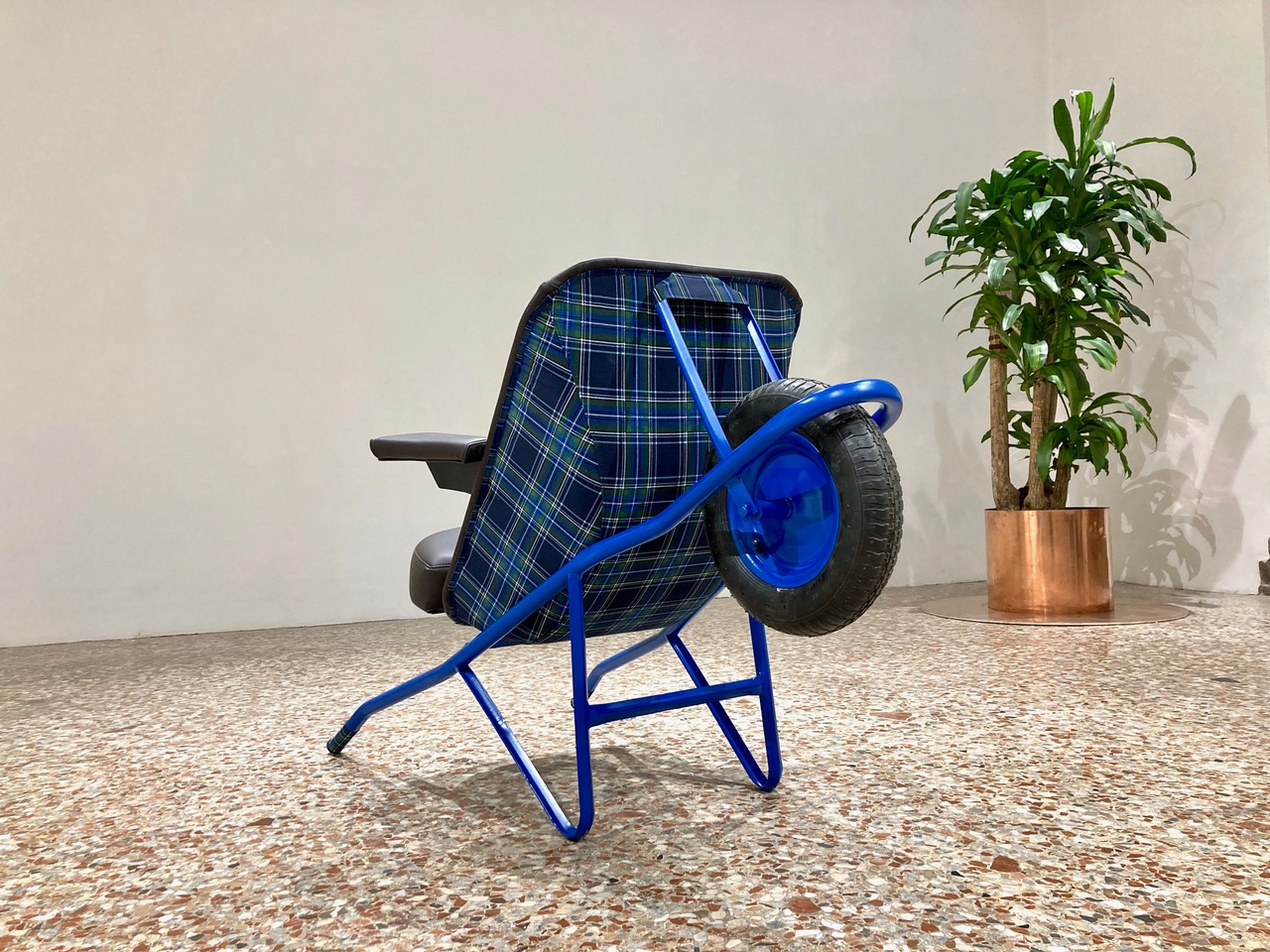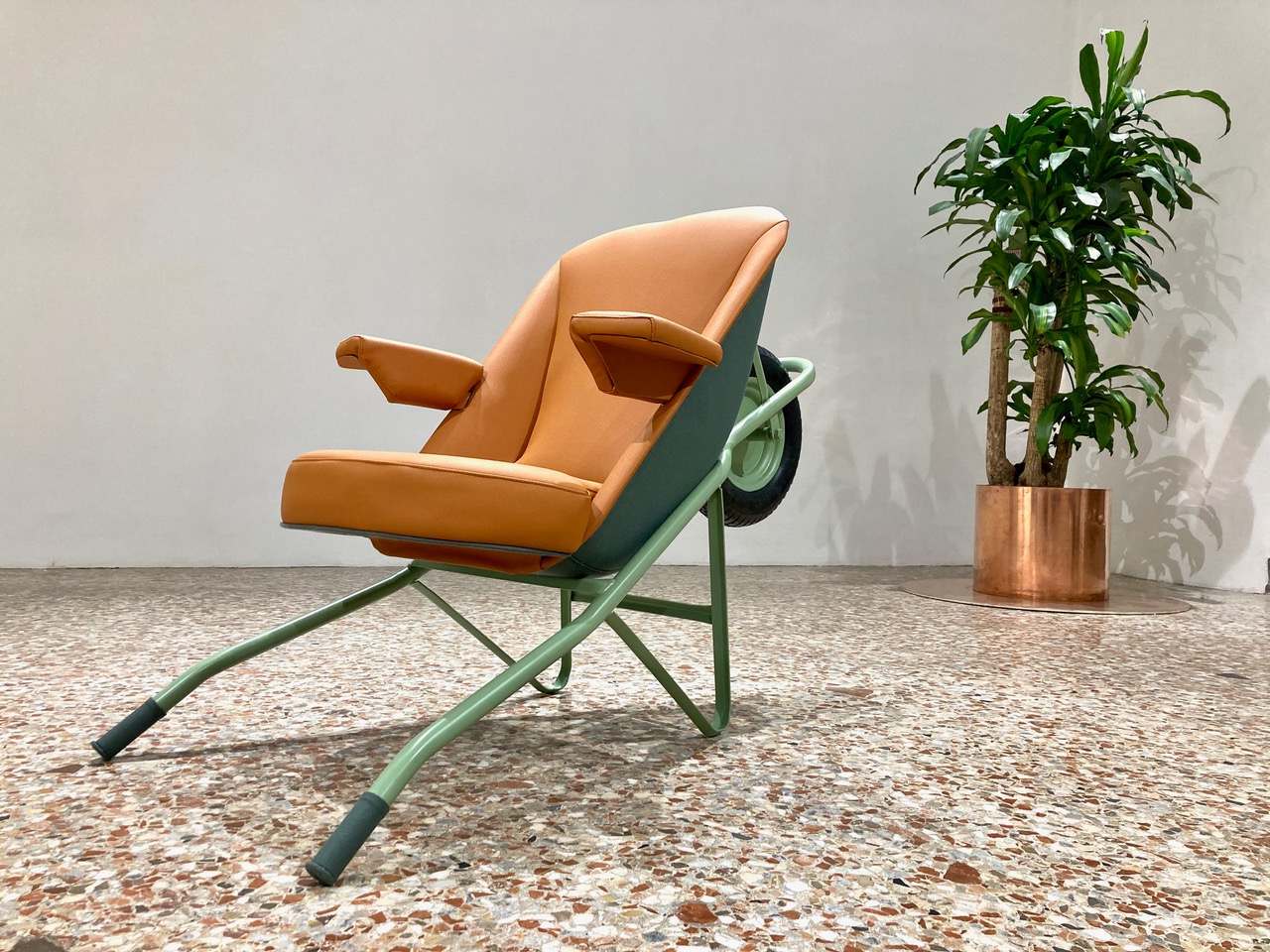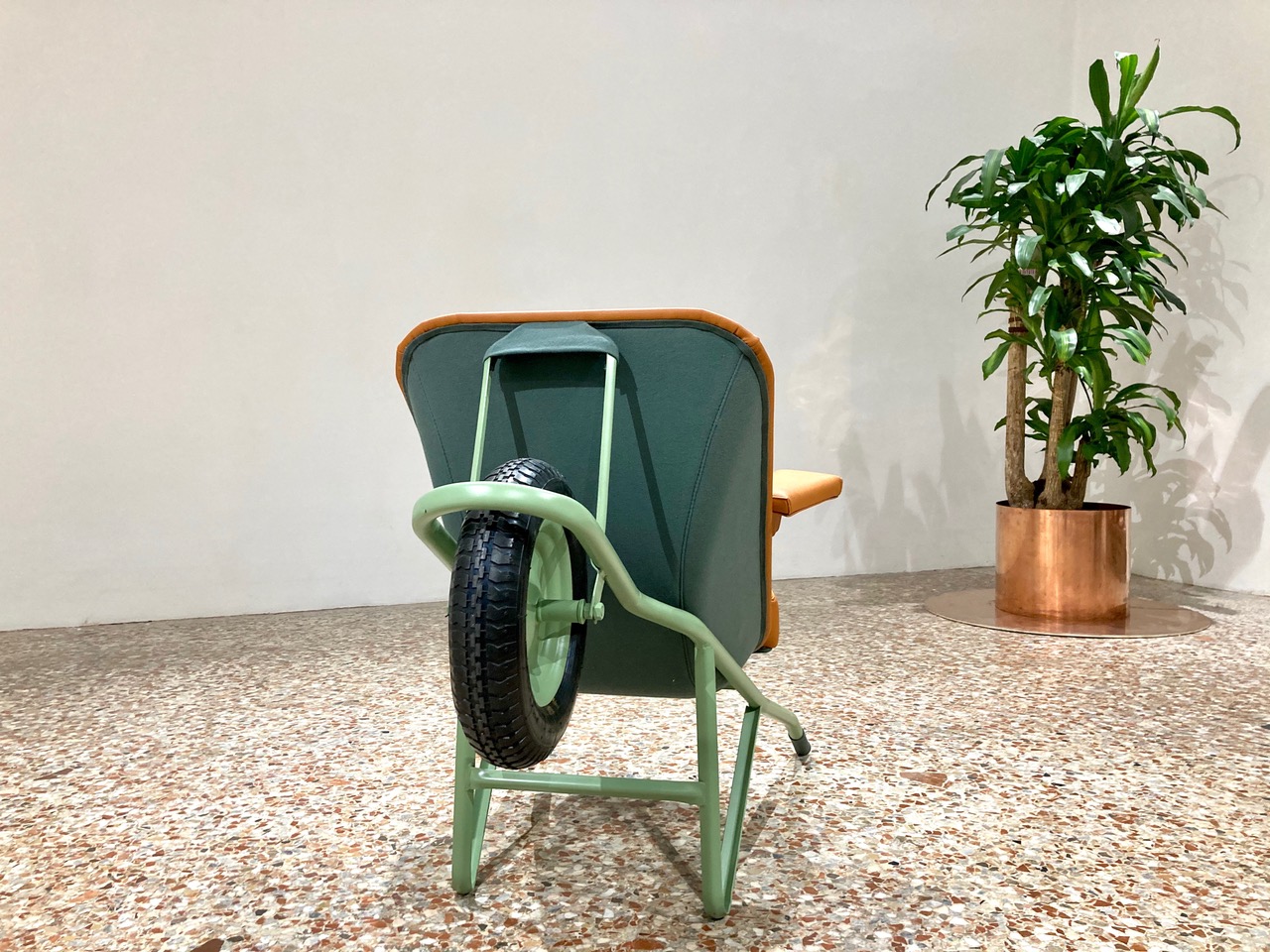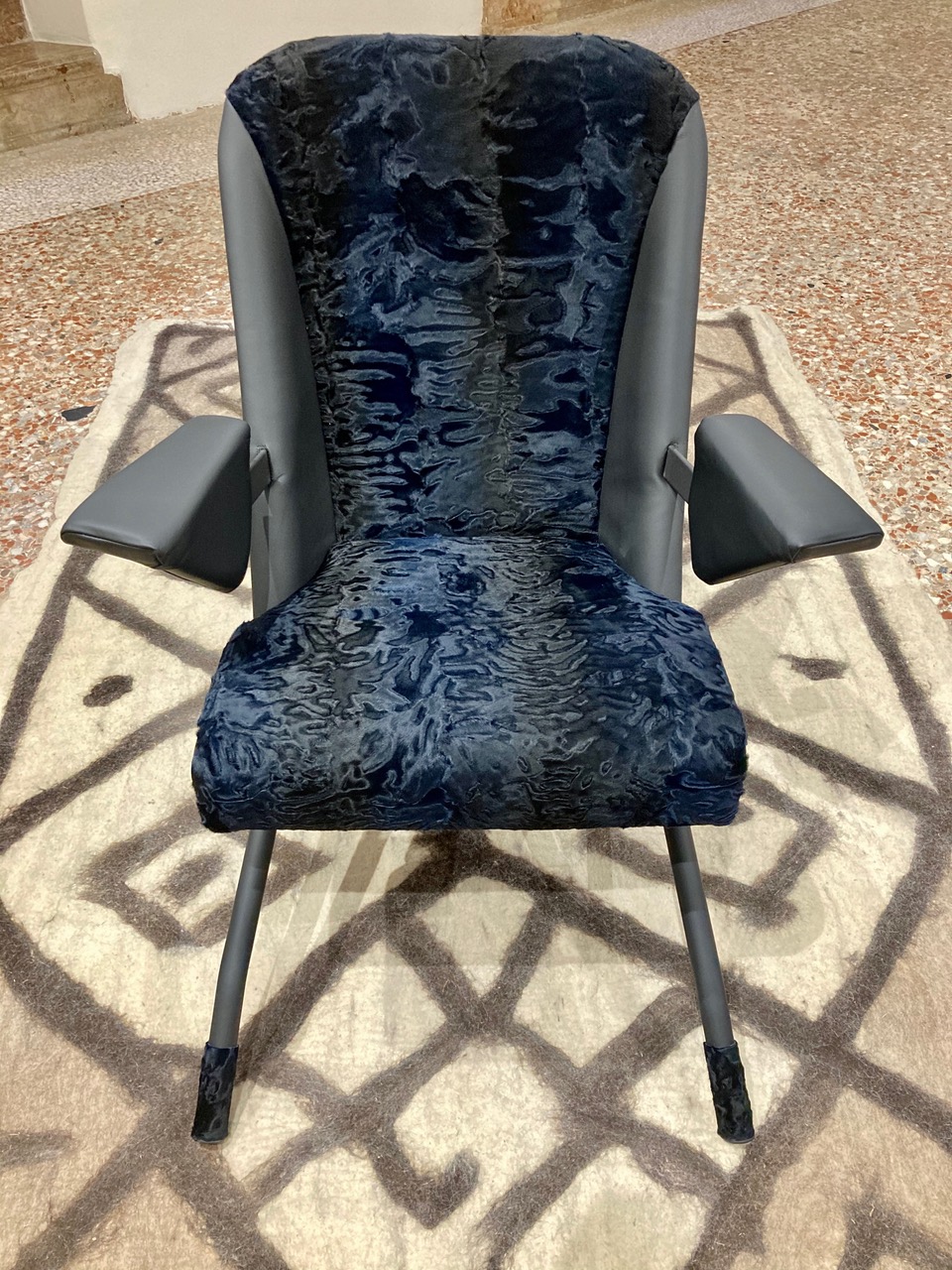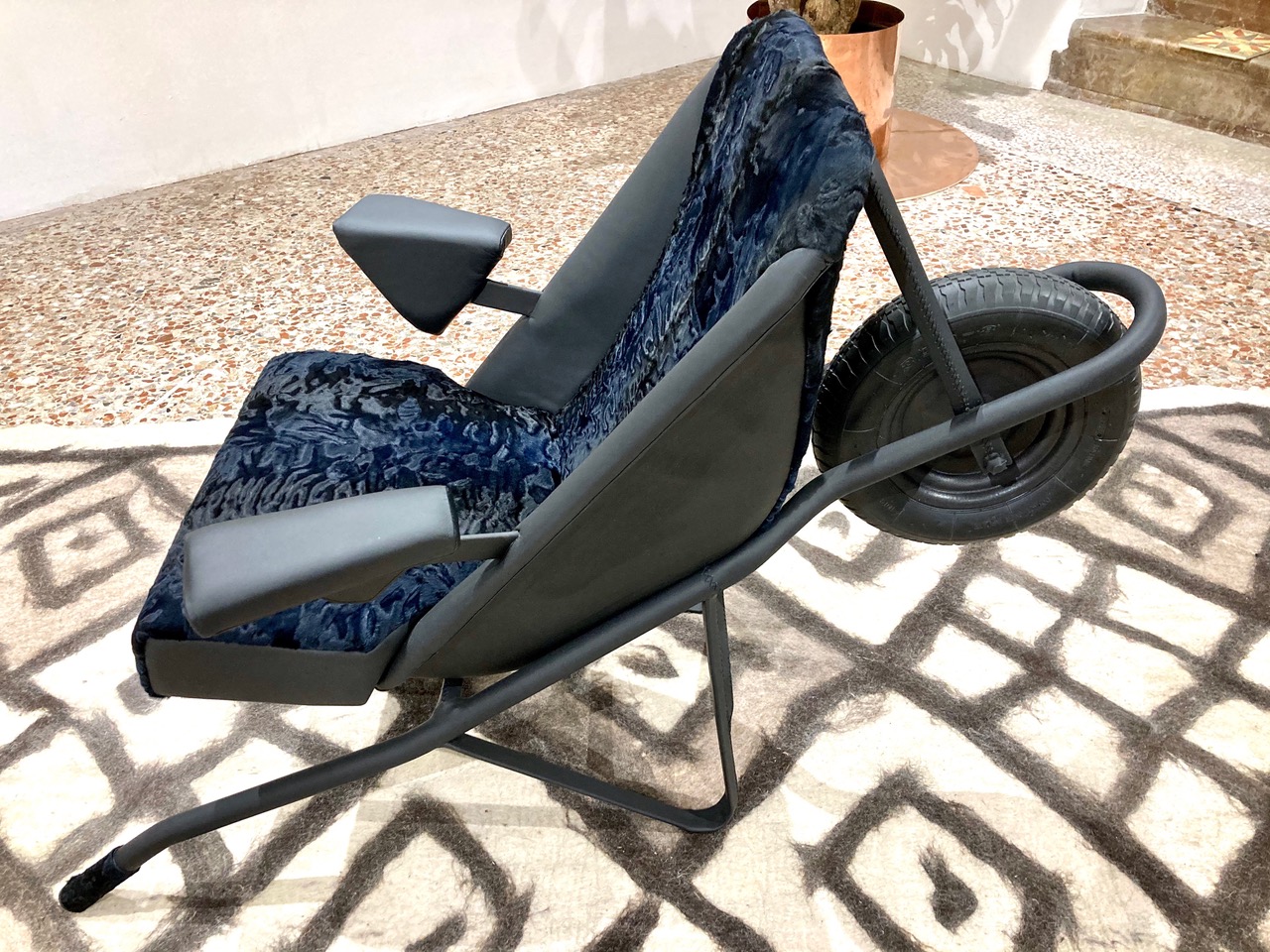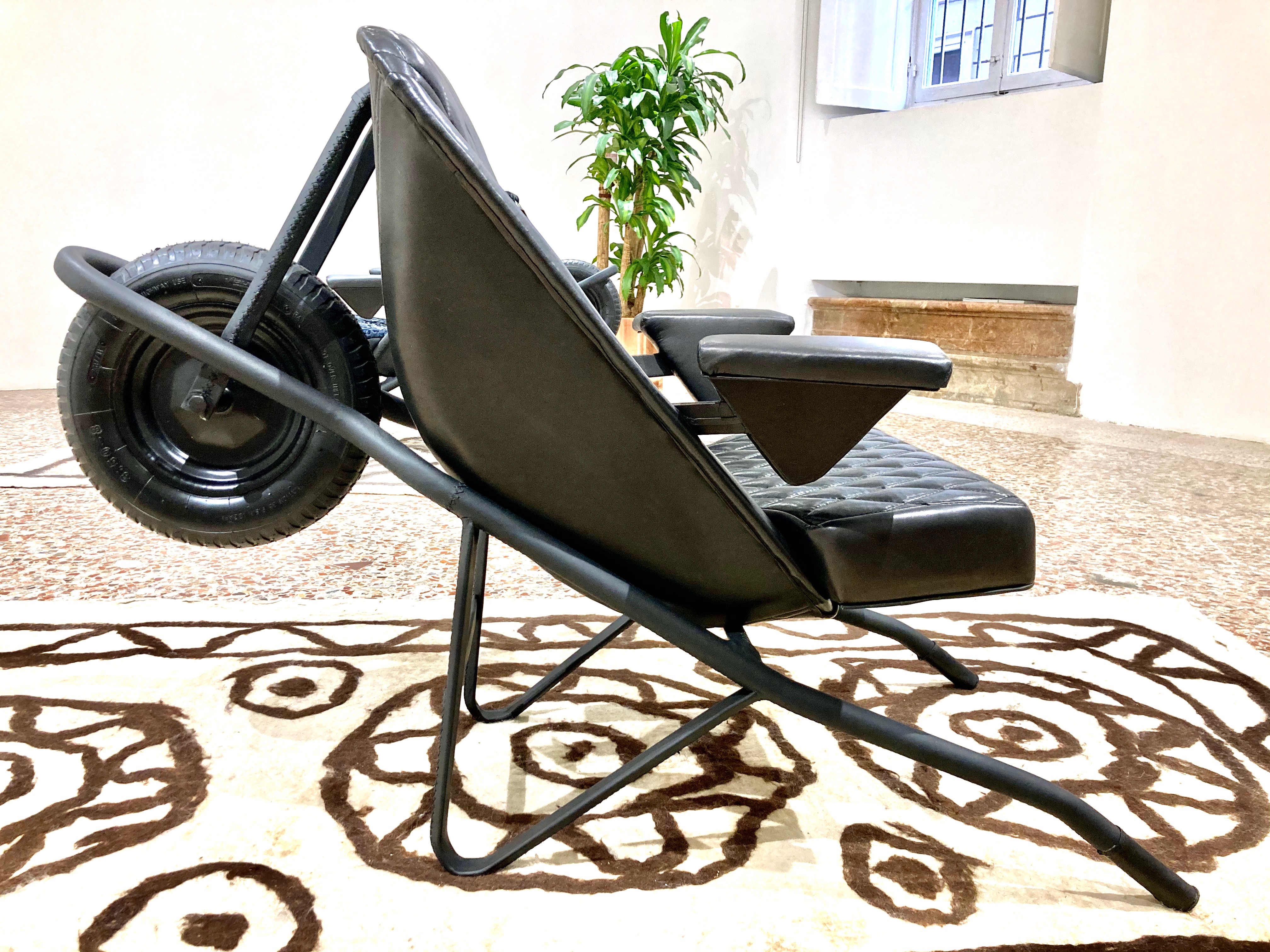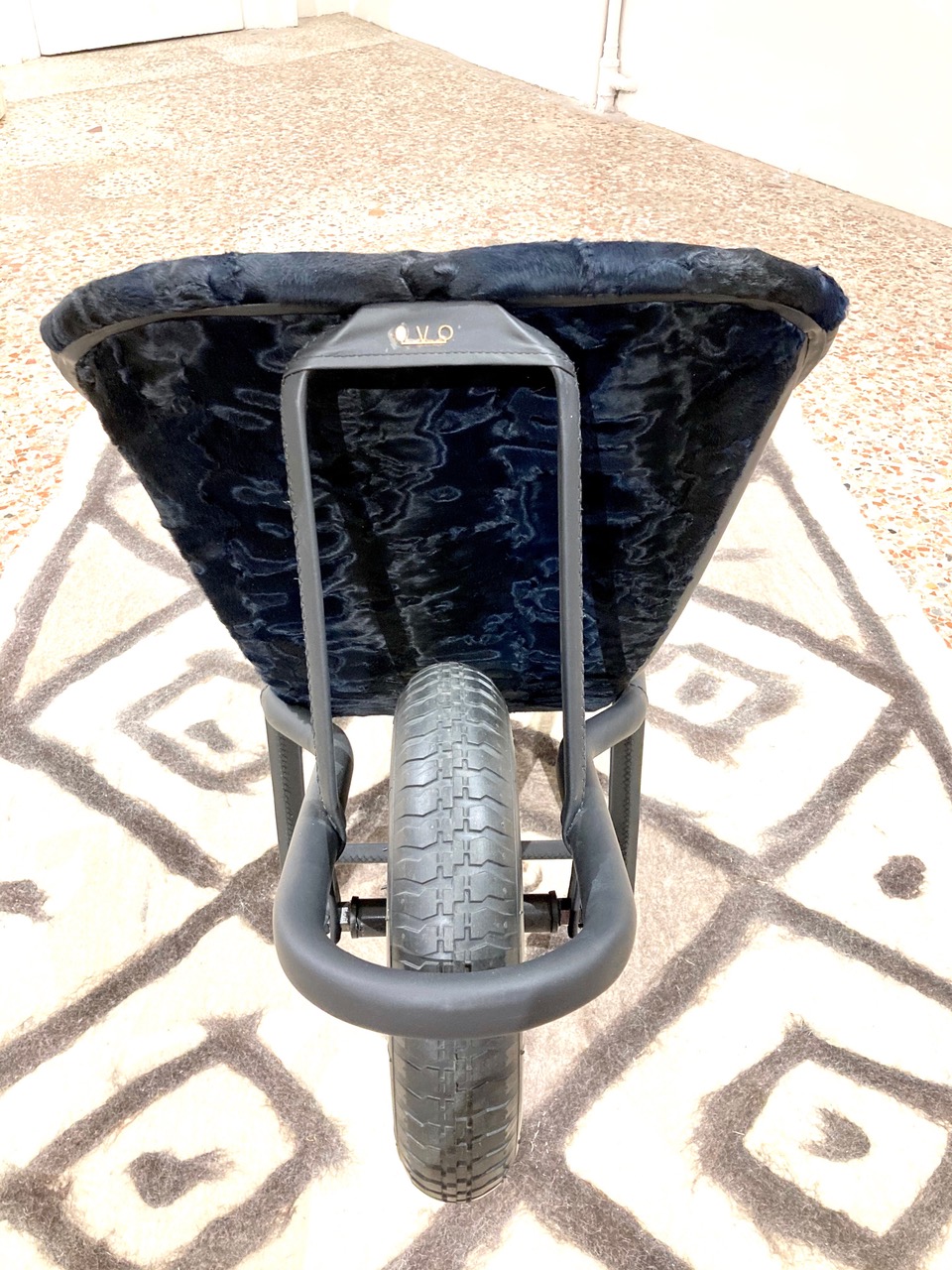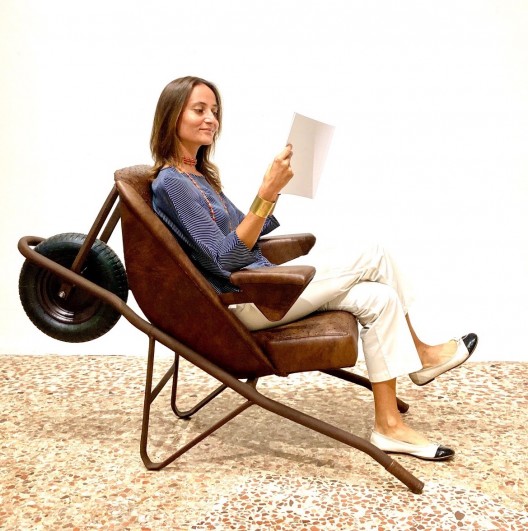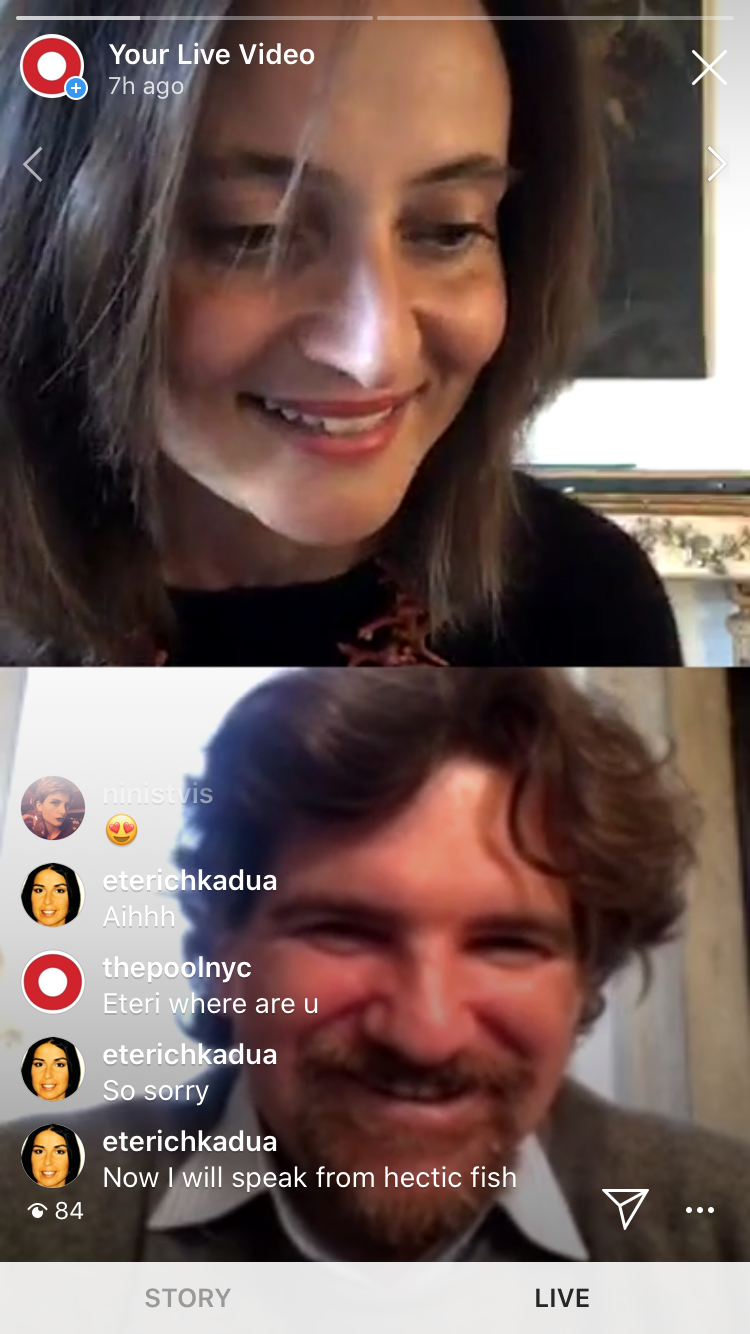| On the occasion of The Italian Glass Weeks happening in Venice 17-25 September 2022, THE POOL NYC presents Oro e d’Arzento, an exhibition devoted to two important materials both in painting and glass: gold and silver. The show will take place at Palazzo Cesari Marchesi, the Venetian space of the gallery first established in New York, and since 2017 in Milan. In the Venetian Lagoon the expression “Oro, Benon!” means: “Great!” and it’s a very popular and fun way to say that everything is going very well. Gold has been used in different ways for painting and sculpture. Thin sheets of gold and silver are used for the production of gold and silver mosaics. Venetian glass with golden leaf dates back to the second half of the 15th Century. In Rosin’s work it is evident that the mirrors turn silver (arzento) and the LUX jellies have mirror parts. Rosin’s sculptures are iridescent, brilliant and precious. The glass, transparent, therefore pure, recalls the main element of Venice: water.
|
THE POOL NYC presenta “I Remember you well in the Chelsea Hotel”: Donald Baechler & Peter Schuyff, una mostra che prende il titolo dalla canzone Chelsea Hotel di Leonard Cohen e celebra due artisti, residenti del leggendario Chelsea Hotel di New York: Donald Baechler e Peter Schuyff.
Lo Show è stato pensato prima dell’improvvisa scomparsa dell’artista americano. Cogliamo dunque l’occasione per salutarlo e celebrarlo.
All’interno della mostra sono visibili lavori degli anni ’90, tra cui una serie di tele di Schuyff presenti nel suo appartamento al Chelsea Hotel.
Le camminate a New York sono infinite passeggiate: si parte da Chelsea e si finisce nell’East Village, senza rendersi conto dei chilometri e passando in rassegna mille volti, mille sapori e una varietà enorme di accenti e architetture.
Camminare a New York è molto più che fare semplici passi, è scoprire nuovi mondi e assaporare nuove culture. Ogni block ha avuto una storia e ne ha una che si farà.
Ogni settimana, rigorosamente, ci fermavano al Chelsea Hotel, 23rd Street and 9th Avenue, uno di quei posti in cui i muri raccontano molte vite, alcune tragiche e altre che sanno di fiaba.
Al Chelsea Hotel ci ha vissuto mezzo mondo dell’Arte: Donald Baechler, Peter Schuyff, Jackson Pollock, Diego Rivera, Robert Mapplethorpe, per non parlare dei cantanti: Janis Joplin, Bob Dylan, Patty Smith, Leonard Cohen e poi gli scrittori: Jack Kerouac, Allen Ginsberg, Arthur Miller, solo per citarne alcuni.
Come tutti gli alberghi che hanno fatto la storia della Grande Mela, alcune camere sono intrise di mistero, sesso e sangue. Famosa è la notte del 1979 in cui Sid Vicious, bassista dei Sex Pistols, uccide la fidanzata Nancy Spungen (ha confessato e poi ha ritrattato).
Ci soffermavamo spesso nella Hall, squallida, mal tenuta, ma sicuramente vera, così conservata per decisione della vecchia proprietà. Si aveva la netta sensazione di essere entrati in un luogo in cui la festa era finita da un pezzo e pure male. Nella stanza a sinistra al lato del camino campeggiava un enorme vaso di fiori di Donald Baechler: era un grande dipinto con un fondo bianco, sporco, ricordava per certi aspetti lo Schifano più in forma, più randagio, onnivoro, che fagocita tutto a qualsiasi ora.
Un soggetto di una disarmante semplicità grafica, nero come la notte, molto potente. La vera protagonista del quadro rimaneva la superficie, lavoratissima, con pezzi di stoffa applicati e ricoperti, tanti strati che traboccavano di colature, un insieme molto sessuale.
Baechler, pittore intrigante, ironico, uno dei pochi che riusciva a rendere sensuale anche un pallone da calcio. L’artista nato in Connecticut e scomparso pochi giorni fa, ritraeva soggetti semplici, un insieme di memorie: nelle sue opere usava frammenti di stampa e tessuti, fotografie, cartoline, souvenir di viaggi per creare un immaginario personale.
Ogni settimana scoprivamo nuove storie d’amore nate al Chelsea Hotel e nuovi inquilini. La favola di New York dove tutto accade non in mezzo a mari cristallini e cieli stellati, ma negli zozzi corridoi di un albergo che non conosce il termine pulizia, ma che ha visto soggiornare stelle e anime ribelli.
Così si scopre che per venti anni ci ha vissuto un altro grande nome dell’Arte degli Anni ’80: Peter Schuyff, olandese volato in Canada e fermatosi infine nell’East Village. La camera di Schuyff era piena di suoi lavori, con un letto a una piazza e mezzo in legno, la coperta bordeaux e poi un camino con tipiche decorazioni di fine Ottocento. I lavori di Schuyff nascono su tele esistenti sulle quali l’artista vi dipinge motivi geometrici ripetitivi, quasi optical, creando nuove superfici, inaspettate e geniali. Nella New York degli anni Ottanta i due artisti convergono nell’East Village, quella parte di Manhattan che da sempre pulsa e raccoglie avanguardie.
I due artisti appartengono alla generazione postmoderna, quella del “Ritorno alla pittura”. In America la decade dell’Ottanta è stata un periodo di prosperità economica e di grande bolla speculativa, ma anche di moralismo bigotto. Fu un decennio adrenalinico, iperbolico e ipertrofico, come fosse stato pompato con gli steroidi. Ogni intellettualismo viene bandito, il quadro non vuole più essere opera, ma “tela e colore”, intriso soltanto di piacere. Nel tipico pastiche postmoderno, particolare importanza aveva la pratica manichea che connetteva astrattismo e figurazione, polarità solo in apparenza antitetiche.
Senza via di scampo, ci si trovava di fronte a una pittura ibrida, incline alla contaminazione degli stili e al rimescolamento delle tecniche. Ancor più che disinvolta, la pittura viene percepita come “disturbante”.
La mostra proposta da THE POOL NYC non vuole certo essere un’operazione nostalgia, bensì una scommessa su quello che potrebbe succedere a breve se l’umanità non è cambiata, se Dostoesvskij è ancora attuale e l’uomo non si è trasformato in un essere tutto buono o tutto cattivo. L’attualità del Postmodernismo e della pittura di Schuyff e Baechler si conferma ancora vincente e ispirante per future generazioni di artisti e creativi, che vivendo senza le certezze della storia dell’arte, prenderanno proprio spunto dall’ironia e dal sarcasmo dei due pittori dell’East Side.
The Louis Vuitton City Guides are small cult objects: lightweight and beautifully made books, they first made their appearance in 1998 and were targeted at typical customers of the French fashion house, curious globetrotters in search of special places.
The volumes cover the traditional categories (hotels, restaurants, bars, nightclubs, objects of quality, art and culture, urban walks), but they do it in a fresh and unexpected way. Thus, Milan takes on the dimension of a multilayered place, in which you can find Michelin-star restaurants and old local hostelries, designer clubs and open-air dance floors, flea markets and art galleries. The look is enhanced by the photographs of the French studio Tendence Flou. But the real attraction is the presence of an exceptional guide, Giovanni Gastel, fashion photographer and nephew of Luchino Visconti.
THE POOL NYC is delighted to be featured on it.
Louis Vuitton’s chic, anti-tourist City Guides are getting a mobile upgrade. You can download app versions on the App Store for iPhone and iPad for $9.99.
Curated by Maurizio Bortolotti
12 November 2021-2 April 2022
THE IDENTITY OF MONGOLIAN ART IN THE HEART OF EURASIA.
It is difficult to understand art in Asia without taking into account its complexity. While globalization has provided an important opportunity in recent decades, enabling it to develop economically and in some cases to overcome the West, it has also confirmed its cultural reception, concealing the most dynamic parts that are local identities. Asia is made up of a myriad of different realities that make the continent a fertile ground for economic and cultural events that are changing the course of the 21st century.
Within this mosaic of identities, Mongolia deserves a place of its own. The country is located on a single large plateau, bordering Russia and China, with a population of about 3 million inhabitants, 800,000 of whom still live as nomads. After gaining independence in 1992, the country is the only democracy in the area still seeking its own identity as a modern country.
The recent constitution of Mongolia has in fact produced a climate of change that has stimulated artistic production. After the end of the Soviet influence with social realism, the Mongol artists directed their production towards two poles: the international art movements of Global Conceptualism, which appears as a form of legitimate updating, and the tradition of Thangka painting, combined with the celebration of the myth of Genghis Khan and the nomadism that still today, centuries later, influence the daily life of Mongolia.
From a more general point of view, we can say that in Asian art the Western concept of “new” has never been assimilated. Even when Western artistic modes spread through globalization, art in Asia remained anchored in a constant dialogue with local tradition. For the same reason, one of the most lively artistic currents in contemporary Mongolia is the one that today re-presents the tradition of Thangka Buddhist painting, declining it in an infinite variety of ways.
The modes of actualization of this tradition pass through contamination with other visual-narrative genres, such as that of the Manga cartoons or the insertion of episodes related to everyday life, to build a new type of narration, who wants to represent the present time.
Originally, it was a kind of religious painting related to the description of Buddha’s prerogatives. Although the approach to this genre is free and not subject to rigid stylistic canons, Thangka painting follows decorative schemes codified with compositions of figures suspended in a perspective space.
In the paintings of the younger generation, the motifs or figures rather than having the meanings proper to the tradition, refer to social and political facts of contemporary Mongolia, developing a self-narration of the current destiny of the country. Figures of horses, knights or Buddha are mixed with contingent facts, which belong to the life of the present. In a vision of reality in which even earth and heaven are spiritual entities that are set against the background of the daily life of a people whose roots are nomadic culture.
Nomadism is present in the stories and in the social and family imagination, handed down also by those who have urbanized in the capital Ulaanbaatar for over two generations. The search for a contemporary identity by a country where nature maintains the strength of its origins, dating back millions of years ago, and part of the population still lives in the nomadic state, with precise rules of life, clashes with the urbanization of the Mongols in the capital Ulaanbaatar, where you live a modern life.
The great narration of the nomadic condition is in fact the nourishment of the Mongolian art, since this narration acts as soundtrack also to the urban life of the great city; on the outskirts of which, and in the vast territory of the country, Nomads still stay in typical Ger tents and ride horses. The tension that arises from Mongolian art is born precisely from the contrast that the Mongols live between modern life and their imagination, populated by the memory of nomadic life. It is a state of mind, but also an identity condition, in which there is an obvious attempt to connect traditional roots with contemporary life. And although there is a widespread knowledge of international art, the Mongolian art scene is mainly focused on itself, in search of its own position that distinguishes it from the rest of Asian art.
Paradoxically, the great theme of Mongolian art is the representation of the myth of nomadic life at a time when the tendency to abandon it in favour of urban life is becoming increasingly evident. It is the reservoir of inspiration of many artists, closely connected with the phase of political and social transformation that the country is experiencing.
For this exhibition we have selected some artists who are representative of the artistic scene in Mongolia, of which we present for the first time in Italy a review.
The issue of urbanization, the transition from nomadic life to the urban condition is the background to the social narrative of the photographer Esunge, who portrays the nomads who have recently settled in the suburbs of the capital Ulaanbaatar. Their lives in the traditional Ger, permanently installed in the suburbs of the city, near the houses, are told without embellishments, trying to grasp the traits of a once proud existence, which represented the national pride. The realism of the images deeply digs the myth of nomadism, even in the condition of survival of the dusty suburbs of the city. The series of portraits is an attempt to fix in the eyes and bodies, old and young, the otherness of the nomadic condition. The portrait of a young man, whose regular features recall a warrior of other times, in his red blouse of traditional workmanship is distinguished from the others because he appears to us as the hero protagonist of an epic narrative of the nation. The attention to the suburbs of the capital, which recall the many shanty town scattered around the world, contrasts with the faces of the nomads, whose intense looks seem to keep the vision of the boundless prairies even in the condition of segregation of the suburbs. It is the tragedy of the process of change in the country in progress, in which the protagonists themselves participate in amazement. The changes affect this exemplary humanity that has abandoned a condition of secular life because of the uncertainty of a future that appears inevitable. In the images of Esunge there is concentrated the search for identity of a people, which is gradually abandoning the traditional costumes while continuing to wear them with pride. Family life in the Ger is timeless, but outside the context of the suburbs describes the urgency of a radical transformation of the country. Modernity dazzles and attracts nomads like moths to the light of a future that seems to offer them no space other than miserable life and without conditions of the outskirts.
Contrary to Esunge’s realism, the imaginary of nomadic life is well represented in the work of Dolgor Serod, who was a pupil of one of the leading masters of Thangka painting in Mongolia. In her work, the decorative and narrative components find a harmonious balance in the name of the Buddhist painting tradition. The scenes of traditional nomadic life are adapted to the decorative structure of the paintings, with flows of figures that move in accordance with secular compositional schemes. In the painting “Mongolian Life” there is the evocation of a glorious past, in which all the ideal elements of nomadic life are orchestrated: the structure of the gear with its internal organization, the altar dedicated to the ancestors opposite of the entrance, to the left the male area, to the right the area of women and children. The herds and horses, traditional means of transport, complete a mythical Eden in the imagination of the Mongols, dreamed even today despite the city life made chaotic by traffic, where the inhabitants live in modern buildings such as those found in residential areas of Chinese cities. The series “Cherry Blossom” is the tale of an ideal nomadic life lost forever. The erotic scenes blend with the resumption of nature and men are in perfect harmony with natural life. While the series dedicated to markets, with the combination of gear to buildings or the representation of the old black market (“Old Back Market”) more closely reflect the reality of contemporary Mongolia. The structures of the paintings in this series follow an archaic scheme of presentation, but the swarm of everyday life, which is the real protagonist of the images, tells of a lifestyle and a sociality with an open structure, organized according to a horizontal scheme instead of pyramidal and hierarchical, which is typical of sedentary civilizations.
For Nomin Bold the traditional representation is the background to insertions of figures that recall the feminine identity. In her compositions, which refer to Thangka painting, female images or those of the Buddha alternate with skulls and other figures wearing gas masks. In her works there is a reinvention of iconography and traditional space. It is a modern space where decorative patterns create a three-dimensional representation. The classical representation, while being the basis and support to the narrative, is continually broken and renewed. Compared to traditional iconography, the artist completely rethinks the decorative structure on which the narrative rests, creating rigorous grids on which are grafted the compositions made with myriad of figures that refer to modern life. There is a double research that completely modernizes the Thangka representation, both in the reinvention of the space of the representation and in the choice of the subjects. In her works the two researches appear complementary but well distinct. In a recent installation, gas masks are crocheted with colored wool and hung on a horizontal wooden bar suspended from the ground, or resting on vertical metal rods. It is a strong stand against pollution and environmental sustainability issues. Despite the apparent fidelity to tradition, the works of Nomin Bold are highly innovative in terms of both iconography and composition, as well as the modernity of the issues addressed. The frontal presentation of the images contrasts with the complexity of the narrative, in which the decorative structure becomes the support for an epic narrative to the feminine.
Even in Baatarzorig Batjargal’s work, tradition is reinterpreted, but the composition with decorative patterns in favor of a broad epic narrative, in which appear battles of the past in which ancient knights participate, in a tangle of half-human and half-animal figures. Its warriors, human beings with animal heads, or giant snakes with dragon faces, give the complex narrative of Baatarzorig Batjargal (curiously, the prefix “Baatar” of its name means hero) the traits of the mythological Monarchy. The Thangka iconography is developed here with symbolic representations of animals and mythological creatures present in Buddhist decorations and ceremonies. The great epic narrative is the central theme of his work, but even in his paintings the reinterpretation of traditional iconography is punctuated by the insertion of elements that populate the imagination of modern Mongolia. In addition to the facts of current politics, he includes quotations that refer to the times of the influence of the Soviet Union. The fantastic traditional repertoire is enriched by the inclusion of bold pop images, such as the series of paintings and sculptures of the Buddha with the head of Mickey Mouse. This quote is not a superficial reference to Western modern art. It shows us the contamination of traditional culture, and it is once again the demonstration of how much the clash between modern life and that of the past is the center through which the search for a cultural and social identity of Mongolia develops. The fantastic figures of the paintings and the references to the profane iconography of modernity tell how the clash between the demons of the past and those of the present did not subside in the vision of the artist, who, although apparently far, it deeply captures the turmoil of today’s Mongolia.
Finally, in the work of Munkhjargal Munkhuu, the youngest of the artists invited, there is the coolest attempt among those proposed to renew Thangka painting combining it with an iconography that recalls the imaginary Manga. In this contamination between the two genres, actuality themes are touched by mixing them with figures of the Buddhist tradition, which only marginally appear in the complex compositions. In his paintings the crowding is greater than in tradition and the three-dimensional space is fluid, solely determined by the movement and the interweaving of the figures. The iconography and type of narration are completely renewed. There are only vague references to the images of the past, the whole representation is projected into the actuality. The works are full of references to events that have influenced social life, with portraits of politicians and leaders of public life in the country, alternating with images of cartoon characters armed, or icons of modernity such as the Rubik’s Cube, KFC fried chicken bags, signs of Mongolian Americanization. In his compositions often stand out numbers that have a symbolic and magical value that are intertwined with the direct coverage of the country. The composition in the paintings is decidedly modern and break with traditional patterns, while maintaining a general layout that recalls the traditional but making it more crowded with characters and objects, almost asphyxiated. There is a dynamism and vitality that tell the frenzy of modern life in the country. His paintings are great allegorical narratives of Mongol society and a pitiless mirror of life in the modern city. The artist’s attitude is critical of a society that, seen with his eyes, appears chaotic and in search of a difficult balance for the identity of an ancient country, but still extraordinarily at the dawn of a new era.
“E in te beltà rivive,
L’aurea beltate ond’ebbero
Ristoro unico a’ mali
[…]
Agli arcani tuoi lari
Ove a me sol sacerdotessa appari,
Regina fu; Citera
E Cipro ove perpetua
Odora primavera …”
(U. Foscolo, Ode “All’amica Risanata”)
“Cosa è mai per il nostro cuore il mondo senza l’amore?
È come una lanterna magica senza luce!
Ma appena tu vi introduci la lampada, le più belle immagini compaiono sulla parete bianca!
E anche se non fossero altro che fantasmi evanescenti,
ci rendono tuttavia felici quando stiamo lí come tanti ragazzi
e andiamo in estasi per queste meravigliose apparizioni…”
(J. W. Goethe, I dolori del giovane Werther)
Love is in the Air: Ugo Foscolo e Antonietta Fagnani Arese
è una mostra nata dall’Idea di Luigi Franchin, Alberto Levi e Viola Romoli
a cura di Roberto Mastroianni
su progetto dello Studio Patricia Bohrer
con la collaborazione di Altreforme, Be Modern, Il Casale Flower Farm,
Jean Blanchaert, Johan & Levi Editore e vago.com
Date: 16 Febbraio – 25 Giugno 2021
Artisti: Franco Albini, Melvin Anderson, Francesco Binfaré, Fulvio Bianconi, Patricia Bohrer, Enrica Borghi, Mario Botta, Eteri Chkadua, Simone Crestani, Francesca Dondoglio, Eileen Gray, Domitilla Harding, Patrick Jacobs, Frank Lloyd Wright, Umberto Mascagni, Massimo Micheluzzi, Ludwig Mies van der Rohe, Aldo Mondino, MVM, Ocra, OVO, Gaetano Pesce, Carlo Prada, Paolo Rizzatto, Maria Grazia Rosin, Ken Scott, Bianca Sforni, Ettore Sottsass, Emilio Tadini, Giuseppe Terragni, Vedovamazzei, Paolo Venini, Vittorio Zecchin.
La Mostra si sviluppa negli spazi di THE POOL NYC a Palazzo Fagnani Ronzoni in Via Santa Maria Fulcorina 20 e da Alberto Levi Gallery in Via San Maurilio, 24 a Milano.
Love is in the Air. Ugo Foscolo e Antonietta Fagnani Arese
di Roberto Mastroianni
Milano 1801-1803, Palazzo Fagnani, Via Santa Maria Fulcorina 20.
Milano 2021-2023, Palazzo Fagnani, Via Santa Maria Fulcorina 20.
Quale migliore occasione del giorno di San Valentino per entrare in questo splendido palazzo in mattoni rossi, fulgido esempio del Barocchetto milanese dall’austera bellezza, che si erge su una stretta via con a lato una chiesa, dedicata a San Matteo alla Banchetta, e che storicamente ospitò i Marchesi Fagnani, divenendo scenario della grande passione intellettuale e amorosa tra due giovani amanti: Ugo Foscolo e Antonietta Fagnani Arese. Fu questa una storia caratterizzata da una ricerca spasmodica del bello e del vero, non disdegnando al contempo la ricerca, anch’essa spasmodica, del piacere e del soddisfacimento delle proprie passioni, dei propri desideri.
Le mura di questo palazzo milanese furono spettatrici silenziose della travolgente storia d’amore tra il poeta e la fascinosa nobildonna e da quella relazione nacque un sodalizio che permise a Foscolo di assorbire Goethe e dare forma alle Lettere di Iacopo Ortis. Antonietta conosceva perfettamente quattro lingue, tra le quali il tedesco, e tradusse per Ugo I Dolori del giovane Werther, libro fondamentale per il formarsi della sua poetica la cui ricezione influenzò profondamente la prima stesura de Le ultime lettere di Iacopo Ortis. Comincia così una liaison dangereuse intensa, passionale e tumultuosa tra i due giovani colti e cosmopoliti.
Fu quella una storia d’amore, che per una serie di vicissitudini ebbe vita breve, e allora vale la pena fare un esperimento mentale e immaginare che i due personaggi si incontrino nel 2021 in un mondo in rapida trasformazione, sotto la pressione di una pandemia globale che mette in luce le contraddizioni di quella tarda modernità, che vede il pianeta diventare “un’ultima sfera unificata attraversata da merci, capitali, testi, simboli e personaggi in visita”[1], che questi due giovani potrebbero abitare all’insegna di un amore per le arti, di un’azione culturale e di un forte impegno civile.
In questa prospettiva, due galleristi – una Fiorentina (Viola Romoli) e un Veneziano (Luigi Franchin) – proprietari di una galleria milanese dal nome newyorkese (THE POOL NYC) mettono a disposizione i loro spazi all’interno di Palazzo Fagnani, al fine di far rivivere la magione dei due amanti, al contempo salotto culturale, alcova e spazio di pensiero e produzione culturale.
La scommessa è immaginare Ugo e Antonietta del XXI secolo vivere i loro spazi e la loro quotidianità, qui ricreati in sinergia tra la Galleria Alberto Levi e THE POOL NYC, all’insegna di passioni artistiche, interesse per il design contemporaneo e per oggetti che, come gli antichi tappeti berberi, evocano viaggi e culture globali e locali. In questo modo, la galleria diventa una specie di “camera delle meraviglie” contemporanea piena di oggetti eccentrici, a volte spudorati o dalla forte carica ironica, scelti da una coppia che incarna amore, passione, cultura, desiderio, avventura e impegno civile.
Il cosmopolitismo, il gusto per il collezionismo e il lusso e l’attenzione alle trasformazioni sociali e politiche, tratti caratteristici del Foscolo e della Fagnani storici, vengono riproposti e riarticolati con attenzione alla contemporaneità, permettendo ai visitatori di entrare in uno spazio, che anche loro potrebbero abitare, pieno di oggetti che anche loro potrebbero possedere, che rappresentano la sintesi di un gusto contemporaneo attento alla qualità estetica, al confort e alla ricerca di quella armonica conciliazione di materialismo e spiritualismo di cui Ugo Foscolo è stato un teorico esemplare.
I giovani Ugo e Antonietta storici si rispecchiano pertanto nel gusto curatoriale e allestitivo di una galleria, che si propone da anni di mettere assieme il meglio dell’arte e dello stile che nasce e attraversa le capitali globali del potere politico, economico e del lusso.
Il gusto del veneziano di origini greche Foscolo e della milanese Fagnani cedono così il passo a quello dei potenziali Ugo e Antonietta contemporanei in un rispecchiamento di attraversamenti territoriali e culturali che vede loro ripercorrere luoghi centrali, ora come allora, per la cultura globale. In questo modo Londra, Parigi, Milano, Firenze e Venezia e la Svizzera dell’Ottocento diventano contraltare delle capitali contemporanee, arricchendosi delle suggestioni che provengono dal design, dall’antiquariato e dalle potenzialità del contemporaneo.
Il nostro esperimento mentale ci pone innanzi alla casa di due giovani collezionisti che vedono, come già il Foscolo, nella bellezza i segni e le tracce simboliche di un passato e di un presente che trovano nell’arte la capacità di dare forma a un progetto di vita all’insegna dell’impegno civile e culturale, nella consapevolezza che solo il bello possa essere consolazione e spunto di riflessione in un’esistenza e in un mondo complesso e conflittuale.
Le opere d’arte, il design e gli oggetti presenti in galleria diventano così parte di una costellazione simbolica, che regala sogni e “illusioni” fondamentali per affrontare la vita e il mondo. Vi è infatti una consapevolezza che accomuna il pensiero foscoliano e il collezionismo contemporaneo ovvero che certi tipi “illusioni”, come le opere d’arte, possano essere un rimedio anche solo momentaneo ai drammi dell’esistenza e che una vita senza arte e cultura non avrebbe senso di essere vissuta.
Possiamo infatti immaginare di ascoltare il poeta nelle stanze della galleria/casa declamare a voce alta ad Antonietta un passo tratto delle sue Lettere:
“Illusioni! Grida il filosofo – Or non è tutto illusione? Tutto! Beati gli antichi che si credeano degni de’ baci delle immortali dive del cielo: che sacrificavano alla Bellezza e alle Grazie; che diffondeano lo splendore della divinità su le imperfezioni dell’uomo, e che trovavano il Bello ed il Vero accarezzando gli idoli della lor fantasia! Illusioni! ma intanto senza di esse io non sentirei la vita che nel dolore, o (che mi spaventa ancor più) nella rigida e nojosa indolenza”[2].
E mentre Antonietta, in un gioco di specchi tra passato e presente, ode le parole dell’amato vede attorno a sé gli oggetti contemporanei che, simili ai “Sepolcri” di cui egli parlerà/ha parlato, si presentano come tracce simboliche di una cultura globale condivisa, la quale dà senso e significato alla nostra comune situazione esistenziale.
Cosa sono infatti le opere d’arte e dell’ingegno umano che trovano collocazione nelle nostre case se non belle presenze e tracce di una tradizione culturale, che è trasmissione di messaggi e forme di vita da un passato comune, che vengono riarticolate e re-interpretate con lo sguardo dell’oggi? E in questa capacità di collezionare gli oggetti, che rappresentano il mondo e la storia degli uomini, non c’è forse il desiderio di collezionare il proprio io culturale e socio-storico attraverso lo sguardo contemporaneo e l’ibridazione dei linguaggi?
In questa prospettiva, il rapporto tra tradizione e innovazione, tra figurazione e astrazione tra design e architettura dà vita a uno spazio dell’abitare che ci pare comune e possibile nella sua storicità e contemporaneità.
Prende così forma la casa dei due giovani collezionisti che si rispecchiano in opere d’arte e oggetti di design e nei “simulacri” e “illusioni” capaci di incarnare il nostro umano desiderio di verità, bellezza e giustizia.
Amore, passione, gioco, arte, letteratura, quotidianità e impegno esistenziale trovano il loro spazio ideale in un’idea di abitazione, in cui la bellezza si presenta anche come possibile consolazione delle sofferenze, dei drammi e dei conflitti provocati dalla nostra condizione esistenziale, amplificati da questi tardo moderni tempi pandemici.
La mostra
Entrare in questa mostra/abitazione, che vuole rendere omaggio a Foscolo e Fagnani, due figure centrali della Milano ottocentesca e per la cultura italiana ed europea, getta il visitatore in uno spazio tempo sospeso, in cui prende forma la celebrazione dell’amore, della ragione, dell’impegno civile e politico, delle passioni, dei piaceri e delle sofferenze quotidiane, e di tutte quelle suggestioni capaci di diventare motore della produzione poetica e letteraria dei due personaggi storici e, nel contempo, immaginare i loro potenziali corrispettivi contemporanei.
La mostra, ispirata alle figure dei due storici amanti, vede gli spazi attraversati della presenza degli Ugo e Antonietta contemporanei e prende così forma un luogo arredato con oggetti che parlano di viaggi, musica, moda, attualità, arte e impegno civile. La mostra attribuisce ai due giovani caratteristiche ritenute fondamentali per l’inizio del XXI secolo: entrambi sono cosmopoliti, europeisti, radicati ma interessati al mondo intero, in cerca di avventura e intellettualmente curiosi e dediti a tutti gli ambiti del sapere, vivono una vita all’insegna del rapporto tra innovazione e tradizione, sono insomma una coppia intellettuale illuminata, sostenitrice dell’ambiente e impegnata nella costruzione di un nuovo risorgimento europeo all’insegna della sostenibilità ambientale e nella promozione di una cultura dei diritti e delle libertà.
La casa, luogo fondamentale per la quotidianità emotiva, intellettuale e sociale e spazio dell’intimità, dove si vive, si soggiorna, si pensa, si crea… diventa in questo modo teatro di un collezionismo contemporaneo raffinato e attento al mutare del gusto, all’ibridazione dei linguaggi e alla sovrapposizione di forme e ispirazioni geografiche e storiche differenti.
La quotidianità si intreccia con forme simboliche dense di messaggi sociali ed esistenziali in una tensione tra il materiale e lo spirituale, che non disdegna il divertimento e la passione.
Entrando nella magione, tramite la monumentale Piscina di Marshmallows di Aldo Mondino (Aldo Mondino, Untitled (Piscina di Marshmallows), Marshmallows, 3,80×7,70 m, 1982), comprendiamo subito che questa è la dimora di due amanti che vedono in quella “una vasca dolce” per perdersi nelle appassionate “acque” dell’amour fou, vivendo la propria storia con passione e nello stesso tempo ricerca pop-ironica.
Passiamo poi negli altri spazi della galleria, trasformati in stanze di una vera e propria casa, con letto, mobili, opere d’arte contemporanea, sculture in vetro e trionfi di tappeti berberi.
Sulle pareti i quadri di Aldo Mondino (“Tropicale”, Olio su Masonite, 180×140 cm, 1964 e “Sufi”, Olio su Linoleum, 120×90 cm,1999) e di Eteri Chkadua (“Unfaithful Wife”, Olio su tela, 130×140 cm,) parlano di viaggi, alterità e suggestioni orientaliste ri-articolate nei linguaggi pop ironici del contemporaneo, mentre le opere di Francesca Dondoglio, indicano l’attenzione dei due giovani amanti per una ricerca sul colore e sull’essenza del dipingere dalla forte “linea analitica”[3], che incarna un “esperienzialismo concettuale” dalla forte tensione spirituale e dalla resa astratto-metafisica, che usa le tensioni tra le monocromie per indagare lo spazio poetico dell’animo umano.
La Progettazione degli spazi e del letto ad opera di Patricia Bohrer rende le gallerie perfettamente vivibili, all’insegna del confort che solo la “casa” può dare, ma nello stesso tempo con un’attenzione al design raffinato, colorato, minimale e giocoso che conferisce ricercatezza a ogni dettaglio, al fine di restituire la personalità di due giovani cresciuti assorbendo le forme e i linguaggi del nostro immaginario globale.
Il design dal gusto contemporaneo e internazionale dialoga in questo modo con gli antichi tappeti berberi di Alberto Levi e con le sculture in vetro di Murano, restituendo il gusto cosmopolita di una coppia capace di accostare il bello e l’utile al di là del tempo e dello spazio, mossa da un gusto che sa rintracciare la continuità tra gli oggetti in uno sguardo e in una prospettiva personale. Sulle pareti le opere di Bianca Sforni (“Datura Maggio 2020”, stampa cromogenica ai Sali d’argento, 81×61 cm, 2020 e “Datura Maggio 2020”, stampa cromogenica ai Sali d’argento, 81×61 cm, 2020) propongono metafisiche e sospese nature morte, che come vanitas contemporanee ci ricordano della fugacità della vita, mentre la scultura di Enrica Borghi (“Venere”, unghie finte e straccio, 2020) ci mostra l’attenzione dei due inquilini della casa/galleria per i temi del riciclo e riuso dei materiali in un’ottica di sostenibilità ambientale e la sensibilità per la gender equality e la condizione femminile, mostrando che tensione socio-politica e gusto possono convivere in forme piacevoli, dal forte valore critico.
Nella Galleria Alberto Levi trova, invece, collocazione lo studio di Ugo e Antonietta, dove gli innamorati trascorrono il loro tempo a leggere, creare, pensare, fare yoga, meditare e ascoltare musica avvolti in una suite di cinque tappeti (nodo simmetrico in lana su trama e ordito in cotone, 1925 circa) disegnati da Jean Burkhalter per Pierre Chareau. Questa suite di tappeti, commissionati originariamente per una residenza in Corsica, è rappresentativa delle diverse sfaccettature stilistiche e compositive della maturità artistica di Burkhalter e attraverso la proposizione di motivi astratti, forme irregolari ad effetto maculato o marmorizzato o tratti dall’ascendenza pittorica, che ricordano superfici lunari e stilemi floreali, che donano alla galleria/studio un’atmosfera sospesa capace di proteggere e promuovere l’intimità umana e intellettuale dei nostri Ugo e Antonietta contemporanei.
La casa- spazio di intimità, quotidianità e relazione- si arricchisce inoltre di un’installazione di Vedovamazzei (“Numero di Telefono Ugo Foscolo”, Neon Light, Neon, 40×6 cm, 2020), mostrando come lo spazio privato sia sempre anche luogo in cui ospitare gli altri, da aprire al mondo e alla relazione, indicando la possibilità di una connessione tra tempi e spazi differenti, rafforzando così la dimensione metafisica di questo esperimento mentale che ha dato vita alla mostra “Love is in the Air. Ugo Foscolo e Antonietta Fagnani Arese”.
[1] Cfr, P. Sloterdijck, Il mondo dentro il capitale, Meltemi, Roma 2008
[2] Cfr. U. Foscolo, Ultime lettere di Jacopo Ortis, “lettera del 15 maggio 1798”
“The entire idea of Creativity affects each individual identity who lives in this planet”.
This is the meaning of making Extra Virgin Olive Oil and Living in Art.
It is a question of the salvation of our Souls. This is our goal when we get to work supporting artists and guarding trees.
OLIO D’ARTISTA is a project conceived by THE POOL NYC Gallery with Giuseppe Stampone, inspired by Joseph Beuys’ Piantagione Paradise.
Always in defense of Nature: defense of Man, Human Values and Creativity.
The label was specially designed by Giuseppe Stampone.
November 2020, Villa Pazzi, Pian de’ Giullari, Firenze
Hand picked Olives; Cold Extraction Extra Virigin Olive Oil.
Olives’ Variety: Moraiolo, Leccino, Frantoio
100% Made In Tuscany
Stampone, an international renowned artist from Abruzzo (his work is in important private collections and museums such as TATE, London, The Museum of Contemporary Art, Houston, MAXXI, Rome, GAMeC, Bergamo) has always been particularly interested in the environment and always admired Beuys’ work. The artist cannot forget the famous abruzzese PARADISE PLANTATION also known as Defence of Nature by German Artist.
Defence of Nature, a project the German Master carried out in Italy in the last 15 years of his life thanks to the solid collaboration of Lucrezia De Domizio and the photographic lens of her husband Buby Durini first took place in the early 1970s when Joseph Beuys began to cultivate a fifteen-hectare plot of land in Bolognano (Abruzzo) destined to the planting of 7,000 bushes and trees that risked extinction: the result was the Piantagione Paradise, or Paradise Plantation. On May 13, 1984, Beuys plants the first Italian oak in the Plantation, right in front of his studio: it is the beginning of the discussion “Defence of Nature,” the veritable emblem of this ambitious Abruzzese project. The Defence of Nature should be understood not just in an ecological sense; actually and more importantly it should be read in terms of its anthropological meaning: defence of man, creativity and human values, topics, more than ever before, of great interest today.
Among the planted trees there were of course olive trees, so much loved by the artist, who used them in several projects, such as Olivestone (1984).
Beuys used oil and stones related to the oil process to make artworks.
This Art Process is related to Creativity and Humanity. Humanity is interpreted in its etymology (comes from the Latin word humilitas, a noun related to the adjective humilis, which may be translated as “from the earth”, since it derives from humus (earth). This action is still very inspiring for us, especially in this moment when Nature is an even more important drive and Art is the access key to the world and the Future.
We wanted to create a new special Organic Product/Artwork made of Art and Humus.
Extra Virgin Olive Oil is crucial in Italy as Art is.
This is why we combined them both and we conceived OLIO D’ARTISTA.
“The entire idea of Creativity affects each individual identity who lives in this planet”.
This is the meaning of making Extra Virgin Olive Oil and Living in Art.
It is a question of the salvation of our Souls. This is our goal when we get to work supporting artists and guarding trees.
OLIO D’ARTISTA is a project conceived by THE POOL NYC Gallery with Giuseppe Stampone, inspired by Joseph Beuys’ Piantagione Paradise.
Always in defense of Nature: defense of Man, Human Values and Creativity.
The label was specially designed by Giuseppe Stampone.
Stampone, an international renowned artist from Abruzzo (his work is in important private collections and museums such as TATE, London, The Museum of Contemporary Art, Houston, MAXXI, Rome, GAMeC, Bergamo) has always been particularly interested in the environment and always admired Beuys’ work. The artist cannot forget the famous abruzzese PARADISE PLANTATION also known as Defence of Nature by German Artist.
Defence of Nature, a project the German Master carried out in Italy in the last 15 years of his life thanks to the solid collaboration of Lucrezia De Domizio and the photographic lens of her husband Buby Durini first took place in the early 1970s when Joseph Beuys began to cultivate a fifteen-hectare plot of land in Bolognano (Abruzzo) destined to the planting of 7,000 bushes and trees that risked extinction: the result was the Piantagione Paradise, or Paradise Plantation. On May 13, 1984, Beuys plants the first Italian oak in the Plantation, right in front of his studio: it is the beginning of the discussion “Defence of Nature,” the veritable emblem of this ambitious Abruzzese project. The Defence of Nature should be understood not just in an ecological sense; actually and more importantly it should be read in terms of its anthropological meaning: defence of man, creativity and human values, topics, more than ever before, of great interest today.
Among the planted trees there were of course olive trees, so much loved by the artist, who used them in several projects, such as Olivestone (1984).
Beuys used oil and stones related to the oil process to make artworks.
This Art Process is related to Creativity and Humanity. Humanity is interpreted in its etymology (comes from the Latin word humilitas, a noun related to the adjective humilis, which may be translated as “from the earth”, since it derives from humus (earth). This action is still very inspiring for us, especially in this moment when Nature is an even more important drive and Art is the access key to the world and the Future.
We wanted to create a new special Organic Product/Artwork made of Art and Humus.
Extra Virgin Olive Oil is crucial in Italy as Art is.
This is why we combined them both and we conceived OLIO D’ARTISTA.
November 2020, Villa Pazzi, Pian de’ Giullari, Firenze
Hand picked Olives; Cold Extraction Extra Virigin Olive Oil.
Olives’ Variety: Moraiolo, Leccino, Frantoio
100% Made In Tuscany
ARCHILEO
a cura di Giacinto Di Pietrantonio
29 Settembre-10 Ottobre
In Occasione di Milano Design City 2020, THE POOL NYC è entusiasta di presentare fisicamente e virtualmente ARCHILEO, l’unica carriola che è anche una poltrona e che vi farà essere felici.
“Datemi un punto d’appoggio e vi solleverò il mondo” diceva il filosofo fisico matematico ARCHImede (288 – 212 a.C.), intendendo per mondo la Terra tutta sollevabile attraverso lo strumento della leva, mentre circa 1700 anni dopo guardando al cielo GaliLEO (1564 – 1642), pur esso filosofo, astronomo e matematico, aggiungeva: “Eppur si muove!”, parlando della Terra non più ferma, ma in movimento intorno al sole. Un secolo prima LEOnardo ideava e progettava meccanismi di mobilità di ogni genere, utilizzati allora e nei secoli successivi.
Il duo designer OVO (Maurizio Orrico – Enrica Vulcano) ha unito queste tre verità filosofico-scientifico-artistiche per realizzare una paradossale seduta mobile chiamata ARCHILEO.
Partendo dalla carriola, uno dei primi, se non addirittura il primo veicolo meccanico, OVO alla Marcel Duchamp o alla Achille Castiglioni, o alla Bruno Munari, ha progettato una seduta che può anche essere agevolmente mossa.
Con un semplice gesto di rifunzionalizzazione OVO ha trasformato un mezzo di trasporto di cose in una poltrona che all’occorrenza può essere spostata anche con la persona seduta.
Così, “se da Cosa nasce Cosa” come diceva Bruno Munari, qui la cosa carriola diventa cosa poltrona ARCHILEO, che promette una seduta come viaggio dell’abitare. Lo stare seduto può qui diventare anche un gioco che mette insieme infanzia e vita adulta: movimento e stasi. Allora la poltrona carriola ARCHILEO diviene anche madeleine proustiana che ci riporta alla nostra infanzia, l’età in cui tutto è gioco e dove anche uno strumento di lavoro viene usato dai bambini come mezzo ludico.
A questo punto diventa evidente che stare seduti in ARCHILEO ci rilassa e diverte allo stesso tempo, rendendoci felici di riposare e consapevoli di poterci spostare.
Dulcis in fundo ci piace sottolineare come questa poltrona rappresenti una gioiosa novità ispirata anche dal logo OVO, dove la O è la ruota, la V il braccio-leva e l’altra O la cassa: O<O.
Orsù, se anche la poltrona si solleva e muove, sentitevi anche voi sollevati e correte a provarla.
I rivestimenti di ARCHILEO sono stati forniti dalla Maison ZILLI-France.
During this 2020 forced Spiritual Retreat, we want to entertain our supporters with thoughts, jokes and Art. We also want to meet artists, and people who can contribute with their vision and art to enjoy the confinement and to turn this moment into something important and enriching for everybody.
This is why Luigi and Viola will go Live on Instagram every Tuesday and Friday at 5 pm (CET).
Follow us @thepoolnyc Cultivate your spirit and stay home!

